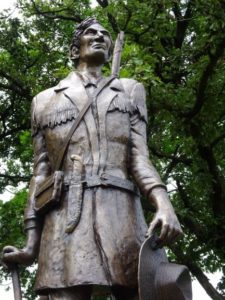 On May 27, 1832, Captain Abraham Lincoln’s company is mustered out of U.S. service by Nathaniel Buckmaster, Brigade major. Lincoln writes the muster roll of his company, certifying that remarks on activities of several members are accurate and just. He then enrolls in company of Capt. Elijah Iles for service in 20-day regiment.
On May 27, 1832, Captain Abraham Lincoln’s company is mustered out of U.S. service by Nathaniel Buckmaster, Brigade major. Lincoln writes the muster roll of his company, certifying that remarks on activities of several members are accurate and just. He then enrolls in company of Capt. Elijah Iles for service in 20-day regiment.
Black Hawk was a chief of the Sauks, a Native American tribe that had crossed the Mississippi River into Illinois from the Iowa Indian Territory. Black Hawk was planning to resettle land that the U.S. government had taken as part of an 1804 treaty. Black Hawk felt the treaty was unjust. With him were about 450 warriors and 1,500 women and children. The government called on Illinois to form a militia to repel what they considered a hostile act.
Lincoln volunteered with sixty-seven other men from the New Salem area to join the battle. Once he arrived at the muster site, Lincoln’s friends pushed him to run for the position of captain. Soldiers voted by forming a line behind one of two candidates, Lincoln or the prosperous sawmill owner William Kilpatrick. To Lincoln’s great surprise, more men lined up behind him, and he became Captain of the Volunteers. In his presidential campaign autobiography, he characterized this event as “a success which gave me more pleasure than any I have had since.”
Lincoln saw no action during the brief war, which was fortunate given how little he knew about military strategy or terminology. At one point he needed to get his men through a gate in a fence but “could not for the life of me remember the proper word of command for getting my company endwise so that it could get through the gate, so as we came near the gate I shouted ‘The company is dismissed for two minutes, when it will fall in again on the other side of the gate.’”
After one month of largely uneventful service, the 1,400-member volunteer army disbanded. Given that he had no job to return to, Lincoln re-enlisted along with about 300 others, this time as a private. A young Lieutenant Robert Anderson mustered Lincoln back into service. Three decades later Anderson was in command of Fort Sumter, whose shelling by the Confederate army started the Civil War. In June, Lincoln re-enlisted again, this time as a private in Dr. Jacob Early’s Independent Spy Company. These few months were the extent of Lincoln’s military experience, and while he saw no action, he did witness some of the brutality of war during several incidents in which his company came across dead and scalped soldiers. After his service, Lincoln headed back to New Salem to find gainful employment.
[Adapted from Lincoln: The Man Who Saved America]
[Photo by author, Kent, IL]
David J. Kent is the author of Lincoln: The Man Who Saved America. His newest Lincoln book is scheduled for release in February 2022. His previous books include Tesla: The Wizard of Electricity and Edison: The Inventor of the Modern World and two specialty e-books: Nikola Tesla: Renewable Energy Ahead of Its Time and Abraham Lincoln and Nikola Tesla: Connected by Fate.
Follow me for updates on my Facebook author page and Goodreads.










